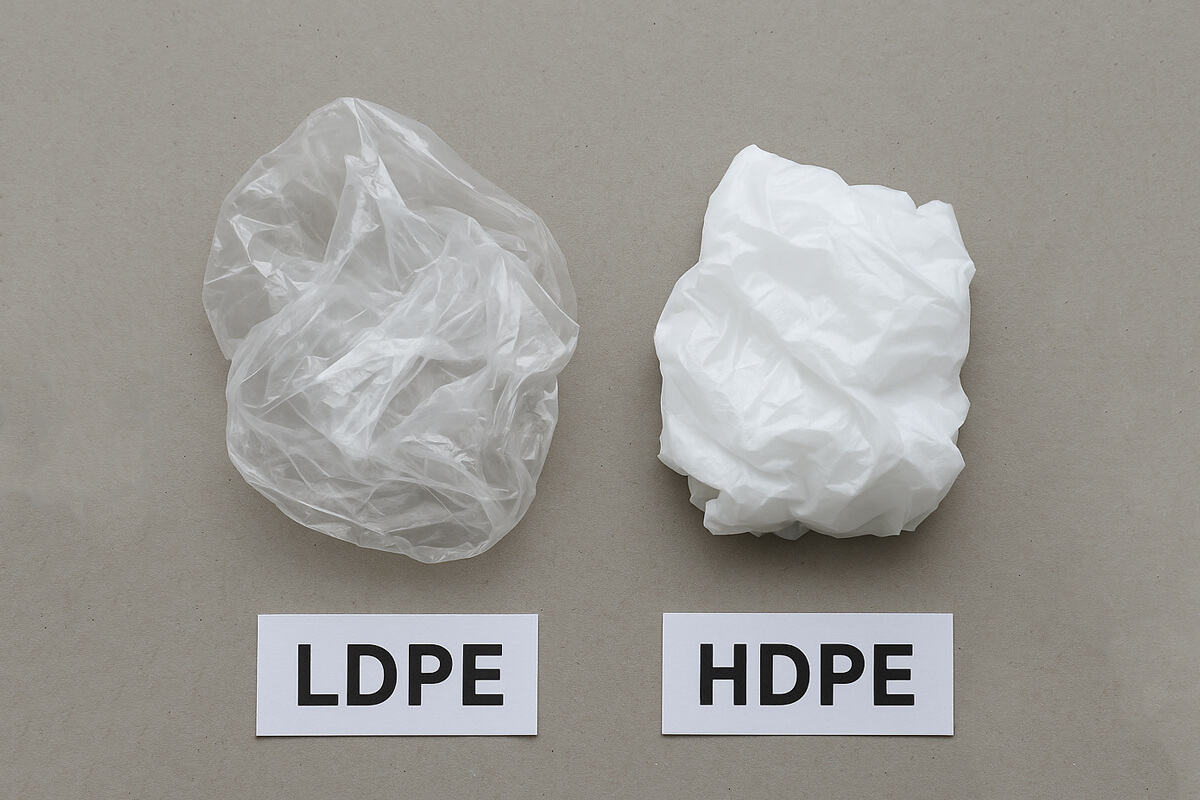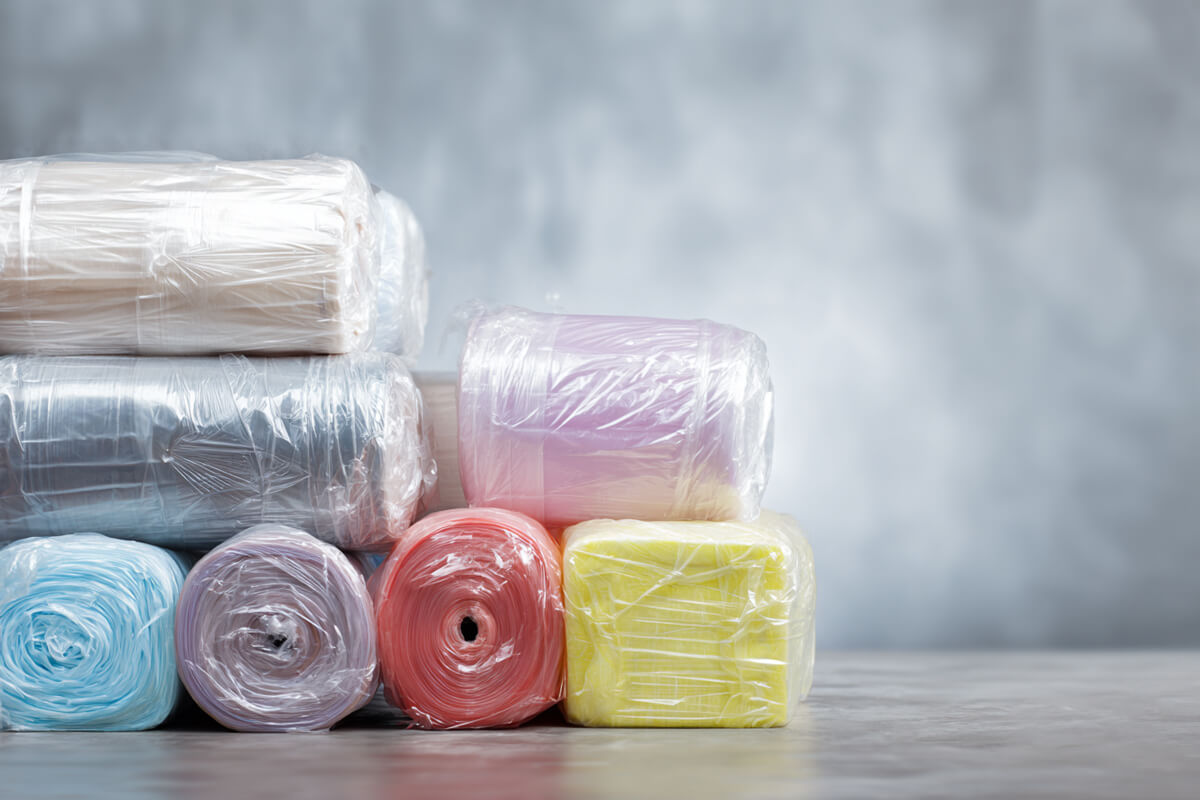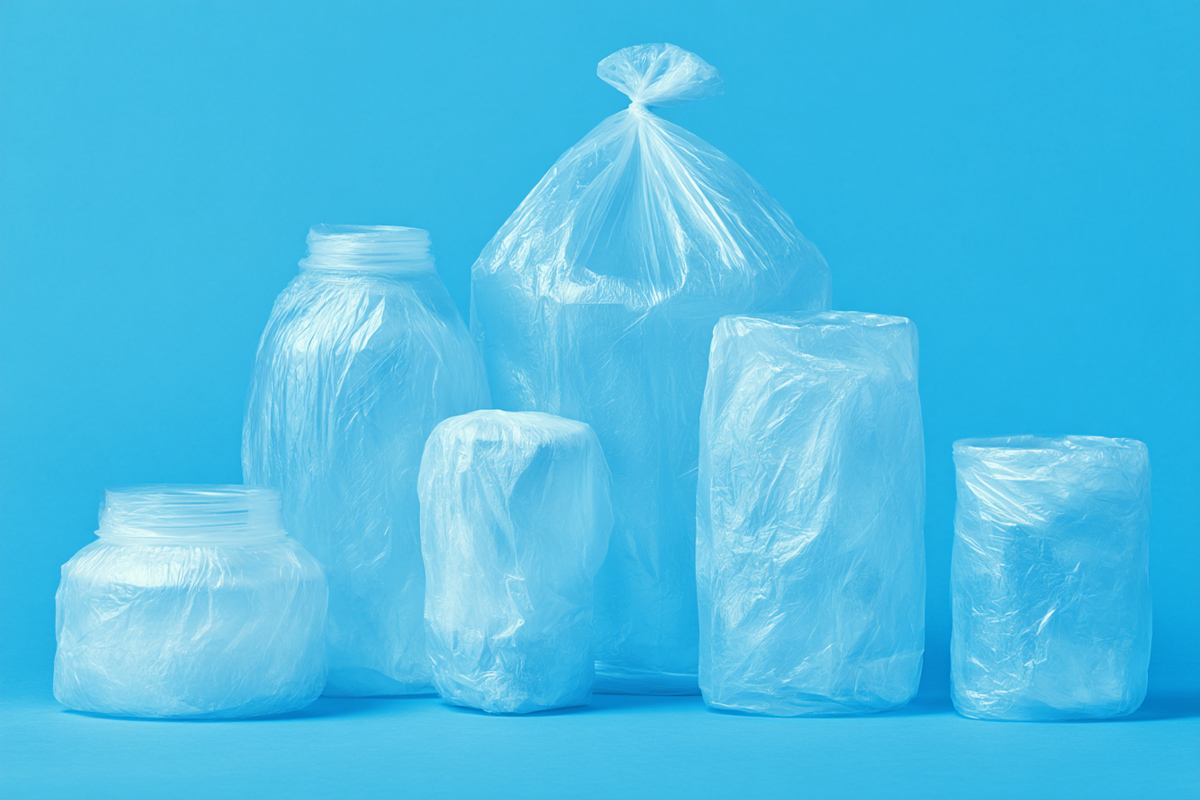Polyethylene accounts for more plastic production worldwide than any other material. You’ll find it in everything from milk bottles to industrial pipes, but not all polyethylene performs the same way. The two main types you’ll encounter are low-density polyethylene (LDPE) and high-density polyethylene (HDPE).
These materials may share the same basic chemistry, but their distinct molecular structures give them properties that make each suitable for different applications. The density difference between these materials affects everything from flexibility to chemical resistance. Your choice between them depends on what performance characteristics matter most for your application.
As polythene suppliers, we see customers make material selection decisions based on incomplete information. This guide explains the key differences between LDPE and HDPE, so you can make informed choices about which material will work best for your requirements.
What is LDPE (Low-Density Polyethylene)?
LDPE has a branched molecular structure that prevents its polymer chains from packing tightly together. This irregular arrangement creates gaps between molecules and results in the material’s lower density.
The branching occurs during the manufacturing process when ethylene gas is compressed in an autoclave or tubular reactor under high pressure. This compression facilitates the linking of monomers into polymer chains, but the conditions also create the side branches that define LDPE’s structure.
This loose molecular arrangement gives LDPE its characteristic flexibility. The material can bend and stretch without breaking because the branched chains can move past each other more easily than tightly packed linear chains. You’ll notice this flexibility immediately when handling LDPE products – they feel softer and more pliable than rigid plastics.
LDPE’s semi-crystalline structure also makes it naturally transparent. The irregular molecular arrangement allows light to pass through more easily than highly ordered crystalline structures. This transparency makes LDPE useful for applications where you need to see the contents inside packaging or containers.
The material melts at relatively low temperatures, typically between 106°C and 115°C. This lower melting point makes LDPE easier to process through injection moulding and heat sealing, but it also limits its use in high-temperature applications.
What is HDPE (High-Density Polyethylene)?
HDPE consists of linear polymer chains with minimal branching. The molecules align in regular, orderly rows that pack together tightly, creating a dense crystalline structure. This tight packing is what gives HDPE its higher density compared to LDPE.
Manufacturing HDPE involves heating petroleum to high temperatures, which releases ethylene gas monomers. These monomers then combine to form the linear polymer chains characteristic of HDPE. The absence of significant branching during this process allows the molecules to arrange themselves in the ordered structure that defines the material.
The tight molecular packing creates strong intermolecular forces between chains. These forces give HDPE its rigidity and high tensile strength – properties that make it suitable for structural applications where materials need to maintain their shape under load.
HDPE’s high degree of crystallinity makes it opaque rather than transparent. The ordered molecular structure scatters light, preventing it from passing through clearly. This opacity can be an advantage in applications where you want to block light or create a more solid appearance.
The material’s melting point ranges from 125°C to 135°C, significantly higher than LDPE. This increased heat resistance allows HDPE to maintain its properties at elevated temperatures, making it suitable for applications involving hot liquids or outdoor exposure where temperature fluctuations occur.
HDPE’s linear structure also contributes to its chemical resistance. The tightly packed molecules create fewer weak points where chemicals can penetrate and cause degradation.
LDPE and HDPE technical specifications comparison
The numerical differences between LDPE and HDPE reveal why these materials perform differently in real applications. Density provides the most fundamental distinction – LDPE ranges from 0.917 to 0.930 g/cm³, while HDPE falls between 0.944 and 0.965 g/cm³.
Physical Properties
| Property | LDPE | HDPE |
|---|---|---|
| Density | 0.917–0.930 g/cm³ | 0.944–0.965 g/cm³ |
| Melting Point | 106–115°C | 125–135°C |
| Tensile Strength | 1,400 psi | 4,000 psi |
| Flexural Modulus | 30,000 psi | 200,000 psi |
| Crystallinity | 50–60% | >90% |
The tensile strength difference is particularly significant. HDPE’s 4,000 psi compared to LDPE’s 1,400 psi means HDPE can handle nearly three times more pulling force before breaking. This difference becomes critical when you need materials that won’t fail under mechanical stress.
Flexural modulus measures resistance to bending. HDPE’s 200,000 psi versus LDPE’s 30,000 psi shows that HDPE is much stiffer. If your application requires materials that maintain their shape, HDPE’s higher modulus prevents unwanted deformation.
Chemical resistance
Both materials perform identically against many chemicals. They both show excellent resistance to dilute acids and alkalis, making them suitable for chemical storage applications. However, both materials show poor resistance to aliphatic and aromatic hydrocarbons, as well as halogenated hydrocarbons.
Temperature performance
The melting point difference affects processing and end-use temperature limits. LDPE’s lower melting point makes it easier to process, but limits its use above 65°C. HDPE maintains its properties at higher temperatures, extending its useful range for hot-fill applications or outdoor use in warm climates.
Water absorption remains minimal for both materials at 0.10% over 24 hours, indicating that neither material will swell or degrade significantly when exposed to moisture.
Key performance differences between LDPE and HDPE
Strength and durability
HDPE withstands significantly more mechanical stress than LDPE. When you pull on HDPE, it resists deformation and maintains its shape under loads that would cause LDPE to stretch or tear. This makes HDPE suitable for load-bearing applications like storage containers or structural components.
LDPE compensates for lower strength with superior flexibility. You can bend LDPE repeatedly without it cracking, whereas HDPE may fracture if forced beyond its elastic limit. This flexibility makes LDPE ideal for applications requiring frequent flexing or movement.
Heat resistance
Temperature tolerance creates distinct application boundaries between these materials. HDPE maintains its structural integrity at temperatures where LDPE begins to soften and lose shape. If your application involves exposure to temperatures above 65°C, HDPE becomes the only viable option.
LDPE’s lower heat resistance does offer processing advantages. The material flows more easily during injection moulding at lower temperatures, reducing energy costs and making it easier to fill complex moulds completely.
Chemical resistance
Both materials resist most common chemicals equally well, but their physical responses differ. HDPE’s rigid structure prevents chemicals from causing dimensional changes, while LDPE may swell slightly when exposed to certain solvents, even if it doesn’t degrade chemically.
Transparency
LDPE allows you to see through it clearly, making it suitable for packaging where product visibility matters. HDPE blocks light transmission entirely, which can be advantageous for protecting light-sensitive contents or creating a more solid appearance.
Processing characteristics
LDPE flows easily during injection moulding due to its branched structure and lower melting point. This makes it suitable for thin-walled products and complex geometries. HDPE requires higher processing temperatures but offers better dimensional stability after cooling.
CNC machining favours HDPE because its rigidity prevents deflection during cutting operations. LDPE’s flexibility can cause chatter and poor surface finishes when machined at high speeds.
When to choose LDPE
Choose LDPE when your application requires materials that can bend, stretch, or deform without breaking. Flexible packaging represents the most common use – grocery bags, food wraps, and flexible pouches all rely on LDPE’s ability to conform to different shapes while maintaining a seal.
Squeeze bottles benefit from LDPE’s flexibility because users need to compress the container to dispense contents. The material returns to its original shape after pressure is released, making it ideal for dispensing applications like shampoo bottles, condiment containers, and cleaning products.
Cable insulation takes advantage of LDPE’s electrical properties and flexibility. The material bends easily around corners and through conduits without cracking, while providing reliable electrical insulation. This combination makes LDPE suitable for both fixed installations and flexible cable applications.
Industry applications
Food packaging operations choose LDPE for its transparency and heat-sealing properties. You can see the contents clearly, and the material forms strong seals at relatively low temperatures. This makes LDPE cost-effective for high-volume packaging operations where speed and reliability matter.
Medical device manufacturers use LDPE for components that require flexibility and chemical resistance. Tubing, flexible containers, and protective covers often specify LDPE because it won’t react with most medical chemicals while maintaining the flexibility needed for patient comfort and device function.
Wire coating applications rely on LDPE’s combination of electrical insulation and flexibility. The material protects conductors while allowing cables to bend during installation and use.
Selection criteria
Select LDPE when transparency matters for your application. If customers need to see product contents or operators need visual confirmation of processes, LDPE’s clarity becomes essential.
Heat sealing requirements often dictate LDPE selection. The material bonds easily at low temperatures, making it suitable for automated packaging operations where speed and energy efficiency matter.
When to choose HDPE
Select HDPE when your application demands structural integrity and resistance to deformation. Chemical storage tanks rely on HDPE’s ability to maintain their shape under pressure while resisting chemical attack. The material won’t bulge or distort when filled with liquids, ensuring consistent performance throughout the container’s life.
Outdoor furniture and playground equipment specify HDPE because it withstands weather exposure without degrading. UV radiation, temperature cycling, and moisture won’t cause the material to crack or fade significantly. This durability eliminates the need for frequent replacement in outdoor applications.
Rigid containers like milk jugs and detergent bottles use HDPE when structural strength matters more than flexibility. The material maintains its shape during handling and stacking, preventing damage during transport and storage.
Industry applications
Construction projects choose HDPE for pipes and fittings because the material handles soil pressure and chemical exposure without failing. Underground installations benefit from HDPE’s resistance to soil chemicals and its ability to maintain structural integrity under load.
Automotive components often specify HDPE for fuel tanks and under-bonnet applications. The material resists automotive fluids while maintaining dimensional stability across the temperature range encountered in vehicle operation.
Industrial equipment manufacturers use HDPE for housings and structural components that must maintain precise dimensions. The material’s low shrinkage and high stiffness ensure that assembled components fit properly and function reliably.
Conclusion
Your material choice between LDPE and HDPE comes down to understanding what your application actually needs to do. If you need something that bends, stretches, or allows you to see through it, LDPE delivers those properties reliably. When your application requires materials that hold their shape under pressure, resist chemicals, or withstand outdoor conditions, HDPE becomes the logical choice.
The technical specifications matter, but they only tell part of the story. Consider how your product will be used, what stresses it will encounter, and what failure modes you need to avoid. A flexible food pouch that tears defeats its purpose just as much as a rigid container that cracks under load.
Both materials have proven themselves across countless applications, but neither works for everything.




